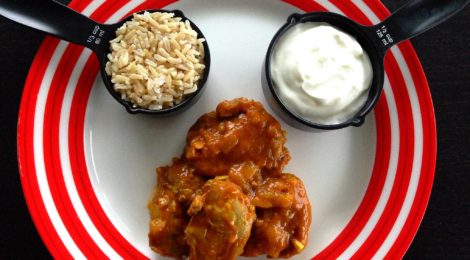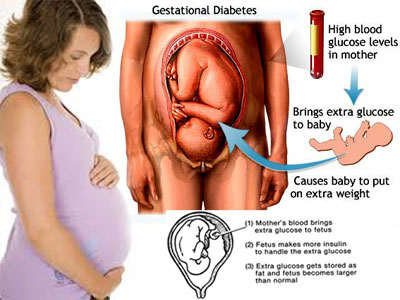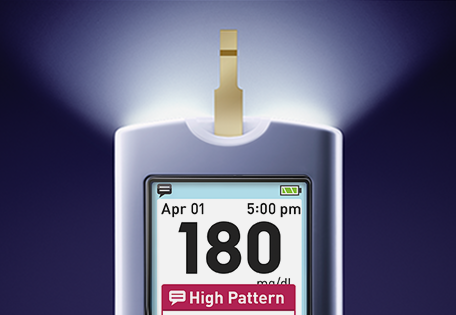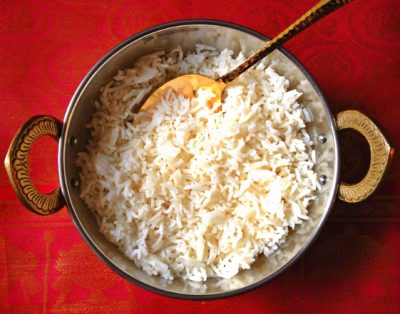
Low-carb Indian dinner for diabetics: chicken curry, brown basmati rice, and yogurt (less than 30g carbs!)

This was my go-to dinner when I was pregnant and diagnosed with gestational diabetes: Daddy’s chicken curry (2 chicken thighs with curry — no potatoes), steamed brown basmati rice (1/3 cup), and plain yogurt (1/2 cup)
Before I was pregnant, I was diagnosed with insulin-resistance, which means my body wasn’t leveraging insulin sufficiently and my blood glucose readings had a tendency to be a bit on the high side. I was never declared a diabetic, but came close to being called “pre-diabetic” and corrected it quickly and easily. Then when I got pregnant, I was thrilled when my fasting blood glucose came in at 77 in the second trimester (they like it to be below 90) but the celebration was cut short when I did the glucose screening required of all pregnant women in the third trimester. First they give you a 1-hour fasting glucose test, which involves showing up at the doctor’s office first thing in the morning on an empty stomach, whereupon they draw your fasting blood to get your glucose reading. Next, you drink a terribly sugary, syrupy orange drink and after one hour they draw your blood again to get a second glucose reading — the two readings tell them how your body processes sugar. I failed this test and was asked to return to do the whole thing over again but this time, it was a 3-hour fasting glucose test, which I also failed.
My doctor called with the official news: I had gestational diabetes. Great. Just the thing I wanted to hear at the end of the second trimester 🙁 Gestational diabetes is common in about 20% of pregnant women, and usually disappears minutes after the baby comes out in delivery. As this diagram shows, high blood glucose levels in the mother can mean the growing fetus takes on extra glucose, causing extra weight gain (more than average) and create complications not only for the baby’s health but also for labor and delivery. It’s no casual affair and imperative to solve right away.

Gestational Diabetes 101 (Source: nursingcrib.com)
Although my meals until then were very healthy and I was a very active pregnant lady (commuting around New York City + prenatal yoga + power walking), mine was a tough case. I was prescribed medication (metformin, glyburide, and insulin (Levemir) injections), I had to exercise, and I had to adopt a very strict eating plan for the last trimester. Very strict. Very. Did I say very? First, I had to test my blood after each meal and the glucose reading had to be less than 120. Breakfast had to be less than 20g of carbs; lunch and dinner had to be less than 40g of carbs; and snacks had to be less than 15g of carbs. So for instance, I could not have oatmeal or cereal for breakfast; strawberries and blueberries first thing in the morning were out of the question too — if I had anything like that, my glucose reading would be way too high.
Mine was a tough case. I was prescribed medication (metformin, glyburide, and insulin (Levemir) injections) and I had to adopt a very strict eating plan during the last trimester.
The real kicker about pregnancy is that the baby is growing rapidly so one’s glucose readings can often be all over the map — one meal might work one day, while it won’t work another day. It’s like a rapidly moving target. Oh yeah, and the raging hormones don’t help either. I had T-minus 11 weeks to figure it out before the baby was due.

This blood glucose “glucometer” became my best friend in the third trimester of pregnancy because I had to test my blood at least 4 times a day (Source: onetouch.com)
Sean and I broke our heads trying to figure out which meals would work for me. The following dinner worked like a charm, and I thoroughly enjoyed the chicken curry stewed with spices, tomatoes, onions, garlic, and ginger, the nuttiness of steamed brown rice, and the cooling effect of yogurt on the side. Because it clocked in at less than 30g of carbs and I could have up to 40g, I would often have a green side salad to round it out:
Low-carb Indian dinner for diabetics — less than 30 grams of carbohydrates!
Daddy’s Chicken Curry (2 thighs and curry — no potatoes!) = 7.1g carbs
Brown Basmati Rice (1/3 cup cooked) = 16.5g carbs
Plain Yogurt (1/2 cup) = 5.4g carbs
Grand total = 29 g carbs
I know how hard it is to find the right meals, so I had to share it with all you struggling diabetics and gestational diabetics out there! This specific dinner was always filling, clocked in at less than 40g carbs AND my post-dinner glucose reading was always around 106 (they like it to be below 120). If you’re looking for creative, tasty ideas, look no further — here’s at least one more recipe you can add to your repertoire!





